Koshi River
The Koshi or Kosi River (Nepali: कोशी नदी, koshī nadī, Hindi: कोसी नदी, kosī nadī) drains the northern slopes of the Himalayas in Tibet and the southern slopes in Nepal. From a major confluence of tributaries north of the Chatra Gorge onwards, the Koshi River is also known as Saptakoshi (Nepali: सप्तकोशी, saptakoshī) for its seven upper tributaries. These include the Tamor River originating from the Kanchenjunga area in the east and Arun River and Sun Koshi from Tibet. The Sun Koshi's tributaries from east to west are Dudh Koshi, Bhote Koshi, Tamakoshi River, Likhu Khola and Indravati. The Saptakoshi crosses into northern Bihar where it branches into distributaries before joining the Ganges near Kursela in Katihar district.[1]
| Koshi (कोसी) Saptakoshi (सप्तकोसी) | |
|---|---|
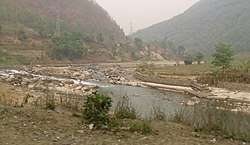 Bhote Koshi in Nepal during the dry season. It is one of the tributaries of Koshi river. | |
 Map of the River Ganges and tributaries | |
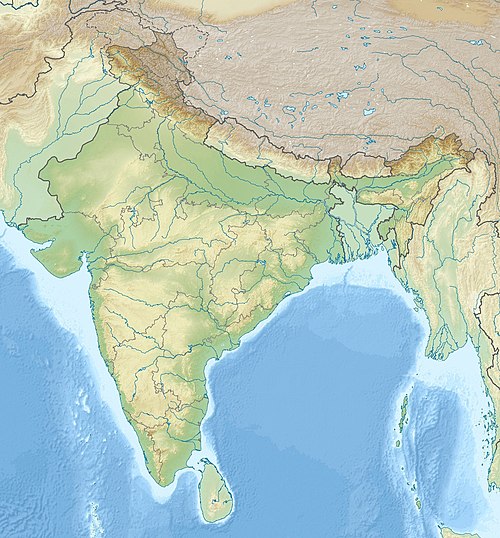 Location of the mouth in India | |
| Location | |
| Country | China, Nepal, India |
| State | Shigatse Prefecture, Province No. 1, Bihar |
| Region | Tibet, Province No. 1, Nepal, North-Central India, East India |
| Cities | Supaul (Bhaptiyahi), Purnia, Katihar |
| Physical characteristics | |
| Source | Sun Koshi, Arun and Tamor form Saptakoshi |
| • location | Tribenighat, Nepal |
| • coordinates | 26°54′47″N 87°09′25″E |
| Mouth | Ganges |
• location | near Kursela, Bihar, India |
• coordinates | 25°24′43″N 87°15′32″E |
| Length | 729 km (453 mi) |
| Basin size | 74,500 km2 (28,800 sq mi) |
| Discharge | |
| • average | 2,500 m3/s (88,000 cu ft/s) |
The Koshi is 720 km (450 mi) long and drains an area of about 74,500 km2 (28,800 sq mi) in Tibet, Nepal and Bihar.[2][3] In the past, several authors proposed that the river has shifted its course for more than 133 km (83 mi) from east to west during the last 200 years. But a review of 28 historical maps dating 1760 to 1960 revealed a slight eastward shift for a long duration, and that the shifting was random and oscillating in nature.[4]
The river basin is surrounded by ridges which separate it from the Yarlung Tsangpo River in the north, the Gandaki in the west and the Mahananda in the east. The river is joined by major tributaries in the Mahabharat Range approximately 48 km (30 mi) north of the Indo-Nepal border. Below the Siwaliks, the river has built up a megafan some 15,000 km2 (5,800 sq mi) in extent, breaking into more than 12 distinct channels, all with shifting courses due to flooding.[5][6] Kamalā, Bāgmati (Kareh) and Budhi Gandak are major tributaries of Koshi in India, besides minor tributaries such as Bhutahi Balān.[7][8]
Its unstable nature has been attributed to the heavy silt it carries during the monsoon season and flooding in India has extreme effects.[9] Fishing is an important enterprise on the river but fishing resources are being depleted and youth are leaving for other areas of work.[10]
Geography

The Koshi River catchment covers six geological and climatic belts varying in altitude from above 8,000 m (26,000 ft) to 95 m (312 ft) comprising the Tibetan plateau, the Himalayas, the Himalayan mid-hill belt, the Mahabharat Range, the Siwalik Hills and the Terai. The Dudh-Koshi sub-basin alone consists of 36 glaciers and 296 glacier lakes.[11] The Koshi River basin borders the Tsangpo River basin in the north, the Mahananda River basin in the east, the Ganges Basin in the south and the Gandaki River basin in the west.[12] The eight tributaries of the basin upstream the Chatra Gorge include from east to west:[13]
- Tamur River with an area of 6,053 km2 (2,337 sq mi) in eastern Nepal;
- Arun River with an area of 33,500 km2 (12,900 sq mi), most of which is in Tibet;
- Sun Koshi with an area of 4,285 km2 (1,654 sq mi) in Nepal and its northern tributaries Dudh Koshi, Likhu Khola, Tama Koshi, Bhote Koshi and Indravati.
The three major tributaries meet at Triveni, from where they are called Sapta Koshi meaning Seven Rivers. After flowing through the Chatra Gorge the Sapta Koshi is controlled by the Koshi Barrage before it drains into the Gangetic plain.[13]
Peaks located in the basin include Mount Everest, Kangchenjunga, Lhotse, Makalu, Cho Oyu and Shishapangma.[14] The Bagmati river sub-basin forms the south-western portion of the overall Koshi basin. The Dudh Koshi joins the Sun Koshi near the Nepalese village of Harkapur. At Barāhkṣetra in Nepal it emerges from the mountains and becomes the Koshi. After flowing another 58 km (36 mi) it crosses into Bihar, India, near Bhimnagar and after another 260 km (160 mi) joins the Ganges near Kursela.
The Koshi alluvial fan is one of the largest in the world. It shows evidence of lateral channel shifting exceeding 120 km (75 mi) during the past 250 years, via at least twelve major channels. The river, which flowed near Purnea in the 18th century, now flows west of Saharsa. A satellite image shows old channels with a confluence before 1731 with the Mahananda River north of Lava.[15]
Floods
The Koshi River is known as the "Sorrow of Bihar" as the annual floods affect about 21,000 km2 (8,100 sq mi) of fertile agricultural lands thereby disturbing the rural economy.[1][16]
The Koshi has an average water flow (discharge) of 2,166 cubic metres per second (76,500 cu ft/s).[17] During floods, it increases to as much as 18 times the average. The greatest recorded flood was 24,200 m3/s (850,000 cu ft/s) on 24 August 1954. The Koshi Barrage has been designed for a peak flood of 27,014 m3/s (954,000 cu ft/s)(2).
Extensive soil erosion and landslides in its upper catchment have produced a silt yield of about 19 m3/ha/year (10 cu yd/acre/yr), one of the highest in the world. Of major tributaries, the Arun brings the greatest amount of coarse silt in proportion to its total sediment load. The river transports sediment down the steep gradients and narrow gorges in the mountains and foothills where the gradient is at least ten metres per km. On the plains beyond Chatra, the gradient falls below one metre per km to as little as 6 cm per km as the river approaches the Ganges. Current slows and the sediment load settles out of the water and is deposited on an immense alluvial fan that has grown to an area of about 15 000 km2. This fan extends some 180 km from its apex where it leaves the foothills, across the international border into Bihar state and on to the Ganges. The river has numerous interlacing channels that shift laterally over the fan from time to time. Without channelisation, floods spread out very widely. The record flow of 24 200 m3/s is equivalent to water a metre deep and more than 24 km wide, flowing at one metre per second.
The Koshi's alluvial fan has fertile soil and abundant groundwater in a part of the world where agricultural land is in great demand. Subsistence farmers balance the threat of starvation with that of floods. As a result, the flood-prone area is densely populated and subject to heavy loss of life. India has more flood deaths than any country except Bangladesh.
2008 flood in Bihar
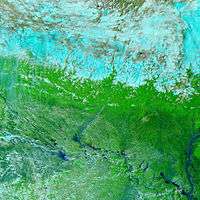

On 18 August 2008, the Koshi river picked up an old channel it had abandoned over 100 years previously near the border with Nepal and India. Approximately 2.7 million people were affected as the river broke its embankment at Kusaha in Nepal, submerging several districts of Nepal and India. 95% of the Koshi's water flowed through the new course.[18] The worst affected districts included Supaul, Araria, Saharsa, Madhepura, Purnia, Katihar, parts of Khagaria and northern parts of Bhagalpur, as well as adjoining regions of Nepal. Relief work was carried out with Indian Air Force helicopters by dropping relief materials from Purnia in the worst hit districts where nearly two million persons were trapped.[19] The magnitude of deaths or destruction were hard to estimate, as the affected areas were inaccessible. 150 people were reported washed away in a single incident.[20] Another news item stated that 42 people had died.[21]
The Government of Bihar convened a technical committee, headed by a retired engineer-in-chief of the water resource department to supervise the restoration work and close the breach in the East Koshi afflux embankment.[21] Indian authorities worked to prevent widening of the breach, and channels were to be dug to direct the water back to the main river bed.[22]
The fury of the Koshi river left at least 2.5 million people marooned in eight districts and inundated 650 km2. The prime Minister of India declared it a national calamity. The Indian Army, National Disaster Response Force (NDRF) and non-government organizations operated the biggest flood rescue operation in India in more than 50 years.[23][24]
Glaciers, glacier lakes and outburst floods
In the Himalayas, glaciers are melting and retreating, which produces lakes insecurely dammed by ice or moraines. These dams are at risk of breaking, causing a Glacial Lake Outburst Flood (GLOF) with flows as great as 10,000 cubic metres a second.
In the past two decades GLOF has become a topic of intense discussion within the development community in Nepal. The Dig Tsho GLOF on 4 August 1985, completely destroyed the nearly completed Namche hydropower plant and all bridges, trails, cultivation fields, houses and livestock along its path to the confluence of the Dudh-Koshi and the Sun-Koshi rivers over 90 km (56 mi). The Dig Tsho glacier is on the terminus of the Langmoche Glacier. This event brought into focus the seriousness of such events and the studies to assess the glaciers, glacier lakes and GLOF followed.
Studies of the glaciers and glacier lakes were carried out in 1988 by a joint Sino-Nepalese team. The Arun-Koshi river basin hosts 737 glaciers and 229 glacier lakes, out of which 24 lakes are potentially dangerous. The Sun-Koshi basin is home to 45 glacier lakes, of which 10 are potentially dangerous. According to a Sino-Nepalese study, since the 1940s on at least 10 occasions, glacier lakes burst their dams. Among them were five bursts in three glacier lakes in the Arun River Basin and four in three glacier lakes of the Sun Koshi River Basin.
Development scenario
Multipurpose projects
The National Flood Control Policy in 1954 (following the disastrous floods of 1954 in a large part of the Koshi river basin) planned to control floods through a series of dams, embankments and river training works. The Koshi project was thus conceptualized (based on investigations between 1946 and 1955), in three continuous interlinked stages – the first was a barrage to anchor the river that had migrated about 120 km (75 mi) westward in the last 250 years laying waste to a huge tract in north Bihar and to provide irrigation and power benefits to Nepal and India. The second part was to build embankments both below and above the barrage to hold the river within the defined channel. The third part envisaged a high multipurpose dam within Nepal at Barakshetra to provide a substantial flood cushion along with large irrigation and power benefits to both countries. This was followed by the Koshi Agreement between Nepal and India signed on 25 April 1954 and revised on 19 December 1966 to address Nepal's concerns. Further letters of Exchange to the Agreement between the two countries identified additional schemes for providing benefits of irrigation. While the first two parts of the plan were implemented by the Government of India, the Koshi High dam, the linchpin of the whole plan, for various political reasons has yet precluded any action for several years but has since been revived under a fresh agreement, in a modified form for further investigations and studies (1,2,3,4 & 5).
Koshi barrage and irrigation

Koshi Barrage, also called Bhimnagar Barrage, was built between 1959 and 1963 and straddles the Indo-Nepal border. It is an irrigation, flood control and hydropower generation project on the Koshi River built under a bilateral agreement between Nepal and India: the entire cost of the project was borne by India. The catchment area of the river is 61,788 km2 (23,856 sq mi) in Nepal at the barrage site. The highest peaks lie in its catchment. About 10% is snow-fed. The Eastern Canal and the Western Canal taking off from the barrage, were designed for a discharge capacity of 455 cubic metres per second (16,100 cu ft/s) to irrigate 6,125 square kilometres (1,514,000 acres) and 210 cubic metres per second (7,400 cu ft/s) to irrigate 3,566.1 square kilometres (881,200 acres), respectively. A hydropower plant has been built on the Eastern Canal, at a canal drop (3.6 km (2.2 mi) from the Koshi Barrage), to generate 20 MW. The Western Koshi Canal provides irrigation to 250 square kilometres (62,000 acres) in Nepal. A valuable bridge over the barrage opened up the East-West highway in the eastern sector of Nepal.
An inundation canal taking off at Chatra, where the Koshi debouches into the plains, has been built to irrigate a gross area of 860 km2 in Nepal. The project was renovated with IDA assistance after Nepal took over the project in 1976.
Koshi embankment system
The Koshi barrage, with earth dams across the river, as well as afflux bunds and embankments above and below the river, confines the river to flow within embankments. Embankments on both sides downstream of the barrage with a length of 246 km (153 mi) were constructed to check the westward movement of the river. The embankments have been kept far apart, about 12 to 16 km (9.9 mi), to serve as a silt trap.
Sapta Koshi High Multipurpose Project (Indo-Nepal)
The governments of India and Nepal agreed to conduct joint investigations and other studies for the preparation of a detailed project report of Sapta Koshi High Dam Multipurpose Project and Sun Koshi Storage-cum-Diversion Scheme to meet the objectives of both countries for development of hydropower, irrigation, flood control and management and navigation. As currently outlined, the dam would displace approximately 75,000 people.
Envisaged are a 269-meter (883 ft) high concrete or rock-filled dam, a barrage, and two canals. The dam is on the Sapta Koshi River with an underground powerhouse, producing 3,000 MW at 50% load factor. The barrage is planned for the Sapta Koshi about 8 km (5.0 mi) downstream of Sapta Koshi High Dam to re-regulate the diverted water. The Eastern Chhatra Canal and Western Chhatra Canal, off-take from the barrage site to provide water for irrigation both in Nepal and India and navigation through Koshi up to Kursela and also in the reservoir of Sapta Koshi dam.
A power canal existing Koshi barrage at Hanuman Nagar is proposed for conveying water for irrigation from the Eastern Chatra Canal and also water that may be required downstream for navigation. To utilize the head available between Chatra and Hanuman Nagar barrages for power generation, three canal power houses, each of 100 MW installed capacity are proposed on the power canal.
Extra storage capacity of Sapta Koshi High Dam would be provided to moderate downstream flooding.
Chatra Canal System would provide irrigation to large areas in Nepal and India (particularly in Bihar).
A Joint Project Office (JPO) has been set up in Nepal for investigation of the project.
Hydropower
Nepal has a total estimated potential of 83,290 MW with economically exploitable potential of 42,140 MW. The Koshi river basin contributes 22,350 MW of this potential including 360 MW from small schemes and 18750 MW from major schemes. The economically exploitable potential is assessed as 10,860 MW (includes the Sapta Koshi Multipurpose Project [3300MW] mentioned above).[25]
Adventure sports
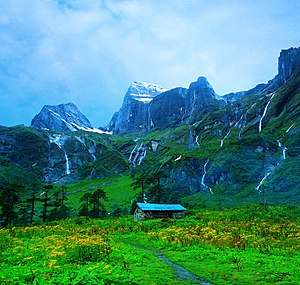
From Kathmandu, a road crosses four major tributaries of the Koshi and reaches trekking paths to Mt Everest. Namche Bazar near the Tibetan border in Nepal (near southern base camp of Mt Everest) is the major tourist centre in the mountainous part of the Koshi belt. Birātnagar in Nepal and Saharsa, Purnia and Katihar in India are major cities on the Koshi Plains. Kamlā, Bāghmati (Kareh) and Budhi Gandak are major tributaries of Koshi in India.
Cultural significance
The Koshi was also called Kausika in Rigveda, Nepal and Bihar in northern India. It is a major tributary of the Ganges. One major tributary of the Koshi is the Arun, much of whose course is in Tibet. This river is mentioned in the epic 'Mahabharata' as Kausiki. Seven Koshis join together to form the 'Saptakoshi River,' or 'Sapt Koshi,' which is popularly known as the Koshi.
Formerly known as 'Kausiki,' named after the sage Viśvāmitra, who is said to have attained the status of Vedic or 'Rishi' on the banks of the river. Viśvāmitra was a descendant of the sage Kusika. Viśvāmitra is credited with writing many well-known Vedic Hymns on the Banks of the Koshi where he had his hermitage — The Mandala 3, the Rigveda, and the Gāyatrī Mantra. The Gāyatrī Mantra is a highly revered mantra based on a Vedic Sanskrit verse from a hymn of the Rigveda (3.62.10).
The mantra is named for its vedic gāyatrī metre as:
- the verse can be interpreted to invoke the deva Savitr, it is often called Sāvitrī
- recitation is traditionally preceded by oṃ and the formula bhūr bhuvaḥ svaḥ, known as the mahāvyāhṛti ("great utterance"). The Gayatri Mantra is repeated and cited very widely in vedic literature,
- this is praised in several well-known classical Hindu texts such as the Manusmṛti, Harivamsa and Bhagavad Gita.
The Koshi (usually rendered Kosi in Sanskrit) is associated with many ancient spiritual stories. It is mentioned in the Bal Kand section of Valmiki Ramayana as the Kausiki who is the form assumed by Satyavati after her death. Satyavati was the elder sister of Viswamitra, descendants of Kushak dynasty. In the Markandeya Purana, the Koshi is described as the primal force. Due to the violent nature of the Koshi during monsoon season, legend says that Parvati, the wife of Shiva, after defeating the demon Durg, became known as the warrior goddess Durga who transformed into Kaushiki. In Ramayana, the river Ganges is depicted as her elder sister.
According to Mahabharata epic, the God of death took the form of a woman and resides on the banks of the river to limit population growth. Koshi resonates with the folklore of Mithila. The most important depictions of Koshi folklore are Koshi as a virgin absolutely care free and full of energy and as a frustrated wife of old hermit Richeek wandering in the Himalayas. Koshi is also invoked as the mother - 'Koshi Ma'. These images capture the contradiction that is inherent in the Koshi River as a source of life and death, prosperity and destruction; a mother and an enchanting virgin.
It is also the lifeline of the 'Mithila' region, today spread over more than half of India's state of 'Bihar'. It is the subject of legend and folklore of the region; the legend of Mithila extends over many centuries. Mithila is also the name of a style of 'Hindu art' created in the area.
Protected areas
In Nepal two protected areas are located in the Koshi River basin.[28]
Sagarmatha National Park
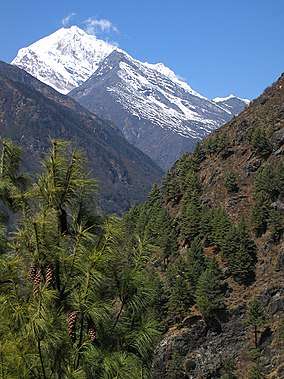
The Sagarmatha National Park encompasses the upper catchments of the Dudh Koshi River system. The park covers an area of 1,148 km2 (443 sq mi) and ranges in elevation from 2,845 m (9,334 ft) to 8,848 m (29,029 ft) at the summit of Mount Everest. Established in 1976 the park was declared a UNESCO World Heritage Site in 1979. The landscape in the park is rugged consisting of mountain peaks, glaciers, rivers, lakes, forests, alpine scrubs and meadows. The forests comprise stands of oak, blue pine, fir, birch, juniper and rhododendron. The park provides habitat for snow leopards, red pandas, musk deer, Himalayan tahrs, and 208 bird species including impeyan pheasant, bearded vulture, snow cock, and the yellow-billed chough.[28]
About 3500 Sherpa people live in villages and seasonal settlements situated along the main tourist trails. Tourism to the region began in the early 1960s. In 2003, about 19,000 tourists arrived in the area.[29] The park's southern entrance is a few hundred metres north of Mondzo at 2,835 m (9,301 ft), a one-day hike from Lukla. A visitor centre is located at the top of a hill in Namche Bazaar.
Koshi Tappu Wildlife Reserve
The Koshi Tappu Wildlife Reserve is situated in the flood plains of the Saptkoshi River in the eastern Terai. It covers an area of 175 km2 (68 sq mi) comprising grasslands and khair–sissoo riverine forests. It was established in 1976 and was declared a Ramsar site in 1987. The reserve provides habitat for hog deer, spotted deer, wild boar, blue bull, gaur, smooth-coated otter, jackal, 485 bird species including 114 water bird species, 200 fish species, 24 reptile and 11 amphibian species.[28] The last surviving population of wild water buffalo in Nepal is found in the reserve, as well as Gangetic dolphin, swamp francolin and rufous-vented prinia.[30] A small population of the critically endangered Bengal florican is present along the Koshi River.[31] There are also records of white-throated bush chat and Finn's weaver. The bristled grassbird breeds in the reserve.[32] The reserve together with the Koshi Barrage was identified as one of 27 Important Bird Areas of Nepal.[33]
References
- Sharma, U. P. (1996). Ecology of the Koshi river in Nepal-India (north Bihar): a typical river ecosystem. In: Jha, P. K., Ghimire, G. P. S., Karmacharya, S. B., Baral, S. R., Lacoul, P. (eds.) Environment and biodiversity in the context of South Asia. Proceedings of the Regional Conference on Environment and Biodiversity, March 7–9, 1994, Kathmandu. Ecological Society, Kathmandu. Pp 92–99.
- "Kosi Basin". Water Resources Information system of India. Archived from the original on 1 June 2016. Retrieved 7 April 2016.
- Nayak, J. (1996). Sediment management of the Kosi River basin in Nepal. In: Walling, D. E. and B. W. Webb (eds.) Erosion and Sediment Yield: Global and Regional Perspectives. Proceedings of the Exeter Symposium July 1996. IAHS Publishing no. 236. Pp. 583–586.
- Chakraborty, T., Kar, R., Ghosh, P., Basu, S. (2010). Kosi megafan: historical records, geomorphology and the recent avulsion of the Kosi River. Quaternary International 227 (2): 143–160.
- Rao, K. L. (1975). India's Water Wealth. Orient Longman Ltd., Hyderabad, New Delhi.
- Verghese, B. G. (1993) "Waters of Hope: Integrated Water Resource Development and Regional Cooperation within the Himalayan-Ganga-Brahmaputra-Barak Basin". Centre for Policy Research, New Delhi and Oxford. IBH Publishing Co., New Delhi.
- "Koshi River". Encyclopædia Britannica. Encyclopædia Britannica Online. Encyclopædia Britannica Inc. 2011. Retrieved 24 August 2007.
- "Koshi River, Bihar, India". San Diego State University. Retrieved 9 March 2019.
- Bapalu, G. V., Sinha, R. (2005). "GIS in Flood Hazard Mapping: a case study of Koshi River Basin, India" (PDF). GIS Development Weekly. 1 (13): 1–6. Archived from the original (PDF) on 5 December 2013. Retrieved 5 September 2013.CS1 maint: multiple names: authors list (link)
- Ranjit, R. (2002). "The current status of capture fishery in the upper Sunkoshi River". FAO Fisheries and Aquaculture Department, Technical Paper: 247–256.
- Bajracharya, S. R., Mool, P. K., Shrestha, B. R. (2007). Impact of climate change on Himalayan glaciers and glacial lakes: case studies on GLOF and associated hazards in Nepal and Bhutan. International Centre for Integrated Mountain Development (ICIMOD).
- Jain, S. K.; Agarwal, P. K.; Singh, V. P. (2007). Hydrology and water resources of India. Dordrecht: Springer. pp. 358–359. ISBN 978-1-4020-5179-1.
- Nepal, S. (2012). Evaluating upstream downstream linkages of Hydrological Dynamics in the Himalayan Region. Dissertation, Faculty of Chemical and Earth Sciences of the Friedrich-Schiller-University Jena.
- Shijin, W., & Tao, Z. (2014). Spatial change detection of glacial lakes in the Koshi River Basin, the Central Himalayas. Environmental Earth Sciences 72(11): 4381–4391.
- Agarwal, R. P.; Bhoj R. (1992). "Evolution of Koshi river fan, India: structural implications and geomorphic significance". International Journal of Remote Sensing. 13 (10): 1891–1901. Bibcode:1992IJRS...13.1891A. doi:10.1080/01431169208904238.
- http://ndrd.gsfc.nasa.gov/ndrdres/flooding/Study_of_koshi_River_Charac.html%5B%5D
- Jain, Sharad K.; Agarwal, P. K.; Singh, V. P. (2007). Hydrology and water resources of India. Springer. p. 341. ISBN 978-1-4020-5179-1. Retrieved 26 April 2011.
- Tewary, A. (2008). "Flood devastation in Bihar state". BBC News. Retrieved 26 August 2008.
- Sharma, T. (2008). "Bihar flood 'catastrophe'; CM seeks Govt's help". Network18. Retrieved 26 August 2008.
- Dainik Hindustan, Darbhanga edition
- "Koshi wreaks havoc in Bihar, claims 42 lives". Press Trust of India. NDTV. 26 August 2008. Archived from the original on 3 September 2008. Retrieved 26 August 2008. dead link
- "Bihar floods: 47 die; thousands marooned". IST, AGENCIES. Times of India. 26 August 2008. Retrieved 26 August 2008.
- "The Deluge". Articles.timesofindia.indiatimes.com. 1 September 2008.
- "Floods in India May Displace Millions". Nytimes.com. Retrieved 30 August 2013.
- "Nepalnews.com Mercantile Connumications Pvt. Ltd". Nepalnews.com.np. Archived from the original on 7 October 2006. Retrieved 30 August 2013.
- Cooper, M. (2009). River Tourism in the South Asian Subcontinent. In: Prideaux, B., Cooper, M. (eds.) River Tourism. Cab International, Oxfordshire, Cambridge. Pp. 23–40.
- Shrestha, J. (1999). Coldwater fish and fisheries in Nepal. Fish and Fisheries at Higher Altitudes: Asia. Issue 385 of FAO fisheries technical paper. Food & Agriculture Organisation. Pp. 13–40.
- Bhuju, U. R., Shakya, P. R., Basnet, T. B., Shrestha, S. (2007). Nepal Biodiversity Resource Book. Protected Areas, Ramsar Sites, and World Heritage Sites Archived 26 July 2011 at the Wayback Machine. International Centre for Integrated Mountain Development, Ministry of Environment, Science and Technology, in cooperation with United Nations Environment Programme, Regional Office for Asia and the Pacific. Kathmandu, Nepal. ISBN 978-92-9115-033-5
- Byers, A. (2005). Contemporary human impacts on Alpine ecosystems in the Sagarmatha (Mt. Everest) national park, Khumbu, Nepal. Annals of the Association of American Geographers 95 (1): 112–140.
- Karki, J. B. (2008). Koshi Tappu Ramsar Site: Updates on Ramsar Information Sheet on Wetlands Archived 14 July 2014 at the Wayback Machine. The Initiation 2 (1): 10–16.
- Baral, H. S., Ram, A. K., Chaudhary, B., Basnet, S., Chaudhary, H., Giri, T. R. and D. Chaudhary (2012). Conservation status of Bengal Florican Houbaropsis bengalensis bengalensis (Gmelin, 1789) (Gruiformes: Otididae) in Koshi Tappu Wildlife Reserve and adjoining areas, eastern Nepal Archived 1 November 2012 at the Wayback Machine. Journal of Threatened Taxa 4(3): 2464–2469.
- BirdLife International. Grasslands
- Baral, H. S. and C. Inskipp (2005). Important Bird Areas in Nepal: Key Sites for Conservation. Bird Conservation Nepal, Kathmandu and BirdLife International, Cambridge
Further reading
- Floods, Flood plains and Environmental Myths – State of Art of India's Environment – A Citizens’ Report, Centre for Science and Environment, 807, Vishal Bhavavn, 95, Nehru Place, New Delhi - 110019.
- A Framework for Sustainable Development of the Ganges- Brahmaputra- Meghna (GBM Region), Proceedings of Conference held in Dhaka, 4–5 December 1999–Nepal Water Vision in the GBM Regional Framework, Institute for Integrated Studies, Kathmandu.
- Water Conflicts in South Asia, Managing Water Resources Disputes Within and Between Countries of the Region (2004), Published by GEE-21Honolulu Hi 96825-0517, USA.
- Barrages in India (1981), Publication number 148, Central Board of Irrigation and Power, Malcha Marg, Chanakyapuri, New Delhi.
- Design and Construction of selected Barrages in India (1981), Publication number 149, Central Board of Irrigation and Power, Malcha Marg, Chanakyapuri, New Delhi.
External links
| Wikimedia Commons has media related to Koshi River. |
- CNN-IBN documentaries on Bihar Floods 2008 by Marya Shakil: Part 1, Part 2, Part 3, Part 4
- Struggling rivers: crying waters
- Legend of Kosi Maiyaa
- GIS in Flood Hazard Mapping: a case study of Koshi River basin, India
- Kosi floods - methods to minimize the effect
- Expert's biggest fear about 2008 floods
- Fixing Kosi - How is that possible
- News Portal from Koshi Area
